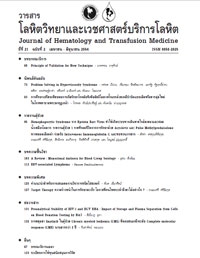การตรวจแอนติเจน D ของหมู่เลือดระบบ Rh ด้วยวิธีไมโครเพลท
Keywords:
แอนติเจน D, วิธีไมโครเพลท, D antigen, Microplate techniqueAbstract
บทคัดย่อ
การตรวจหาแอนติเจน D ด้วยวิธีมาตรฐานหลอดทดลอง ต้องใช้น้ำยา anti-D ชนิดเข้มข้น ทำให้ต้นทุนสูงและไม่เหมาะสมกับการตรวจตัวอย่างจำนวนมาก การศึกษานี้เพื่อประยุกต์ใช้วิธีการตรวจหาแอนติเจน D ด้วยวิธีไมโครเพลท ซึ่งได้ศึกษาภาวะที่เหมาะสมในการตรวจแล้วทดสอบกับตัวอย่างเลือดของผู้บริจาคโลหิตของศูนย์บริการโลหิตแห่งชาติ สภากาชาดไทย จำนวน 12,921 ราย ซึ่งได้ทำการเจือจางเม็ดเลือดแดงให้ได้ความเข้มข้นประมาณ 1% ถึง 3% ในน้ำยา low ionic strength (LISS) โดยใช้ stick method ทดสอบกับน้ำยา anti-D ที่เจือจาง 1:50 หากได้ผลลบด้วยตาเปล่า จะทำการตรวจเพิ่มเติมเพื่อยืนยัน weak D ด้วยวิธีหลอดทดลอง จากผลการตรวจแอนติเจน D ด้วยวิธีไมโครเพลทและอ่านผลด้วยตาเปล่าพบว่า ให้ผลบวก (Rh positive) 12,835 ราย (ร้อยละ 99.3) และให้ผลลบ 86 ราย (ร้อยละ 0.7) ซึ่งผลการตรวจเพิ่มเติมด้วย indirect antiglobulin test พบว่า เป็น Rh negative 84 ราย (ร้อยละ 0.65) และเป็น weak D 2 ราย (ร้อยละ 0.05) โดยสรุปการศึกษาครั้งนี้ได้ทำการตรวจแอนติเจน D ด้วยวิธีไมโครเพลท ซึ่งให้ผลถูกต้องสอดคล้องกับวิธีมาตรฐาน อีกทั้งสามารถลดต้นทุนค่าใช้จ่ายได้ถึง 2.5 เท่า เมื่อเปรียบเทียบกับวิธีหลอดทดลอง และลดเวลาการทดสอบในกรณีที่มีตัวอย่างตรวจจำนวนมากพร้อมกัน
Key Words : แอนติเจน D ; วิธีไมโครเพลท
Abstract
Disadvantages of the standard tube technique (STT) for D antigen typing are high cost due to the use of undiluted anti-D and not suitable for mass screening. This study aimed to modify microplate technique for D antigen typing. Appropriate conditions for testing were performed. Altogether, 12,921 blood samples obtained from blood donors of the National Blood Centre, Thai Red Cross Society were included. Red blood cells of each sample were diluted to 1-3% in low ionic strength solution (LISS) using stick method and tested with diluted anti-D (1:50). Weak D confirmation test by STT was performed in a case of negative reaction by naked eyes. Regarding the D antigen typing results read by naked eyes, it was found that positive reactions (Rh positive) were 12,835 cases (99.3%) and negative reactions were 86 cases (0.7%). Following confirmation test by indirect antiglobulin test, there were 84 Rh negative (0.65%) and 2 weak D cases (0.05%). In conclusion, D antigen typing was performed by modified microplate technique. All results obtained were concordance with standard technique. Additionally, the total cost of this technique is 2.5 times cheaper than STT and less time consuming for mass screening.
Key Words : D antigen ; Microplate technique



